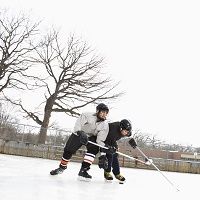Article
Mumps Outbreak Sidelines Several Hockey Players
Author(s):
During a National Hockey League (NHL) season it is not uncommon for players to be sidelined with bumps and bruises. In recent weeks, players at the sport's elite level have been more concerned with catching mumps than healing their bumps.

During a National Hockey League (NHL) season it is not uncommon for players to be sidelined with bumps and bruises. In recent weeks, players at the sport’s elite level have been more concerned with catching mumps than healing their bumps.
So far at least 14 players on several NHL teams have had confirmed diagnoses according to a story on the league’s website. For players who are used to skating with ease, the disease, which is more commonly associated with children, has left them with symptoms ranging from fever, headaches, and a loss of appetite.
With the mumps spread through saliva or mucus, players with mumps have been forced to sit on the sidelines until their treatment progresses past the point of them being infectious.
The US Centers for Disease Control and Prevention (CDC) website noted that “Mumps is no longer very common in the United States,” adding that in most years only a few hundred people might contract the disease. Compare that to 1967 when there were 186,000 cases and it is clear the precautions have worked for the most part. While the number of cases has dropped in recent years 2014 has been worse than others as the CDC reported 1078 reported cases of mumps between Jan. 1 and Nov. 29. That is a drastic difference from the 438 cases reported in all of 2013.
Other notable outbreaks occurred in 2006, when there were more than 6500 cases reported with many of them occurring on college campuses, and between 2009 and 2010 when there were around 3000 cases reported around a religious community in New York City. That outbreak was traced to a child who had been in the United Kingdom where they were also having a mumps event.
These days with many people getting the measles mumps and rubella vaccine concerns of the mumps have been minimized and virtually eliminated. In a video posted on the North Shore LIJ Health System website Lorry Rubin, MD, the chief of pediatrics, explained that the vaccine may not be enough to prevent people from getting the disease.
“This vaccine is quite effective in preventing mumps but it’s certainly not 100% effective so that there are some people who will remain susceptible even after the two doses,” he said. “There may be some people who get protected by the vaccine but the protection wanes or decreases over time.”
While there is no way to know how long the outbreak will last or how many players will be diagnosed with the mumps before the end several teams are taking steps to minimize the damage by taking precautions including booster shots and sterilizing their facilities and equipment.
The CDC noted that most mumps patients “fully recover after a few weeks,” after the symptoms pass. No matter how tough a hockey player is the CDC said containment and prevention is key to keeping the virus from spreading too rampantly.
“The risk of spreading the virus increases the longer and the closer the contact is with someone who has the infection,” they said on their website. “When a person is ill with mumps, he or she should avoid contact with others from the time of diagnosis until at least 5 days after the onset of parotitis by staying home from work or school and staying in a separate room if possible.”





